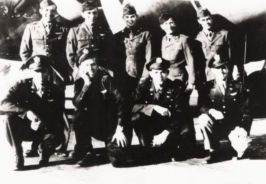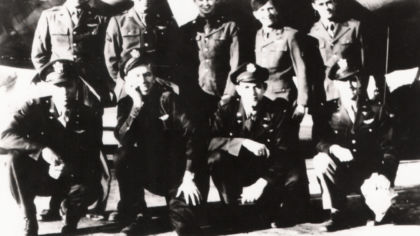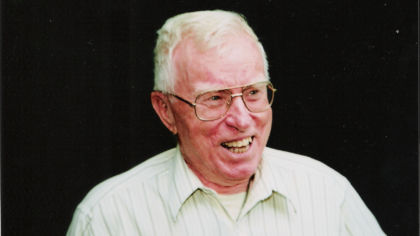Robert A. Norvell
Murder at Konopiště Castle
Robert A. Norvell, Bomber Commander, 849th Bomb Squadron, 490th Bombardment Group, 8th Air Force
It was April 19, 1945. There were just three weeks left until the end of the war in Europe and the U.S. Air Force and RAF were destroying one target after another, with unrelenting strength. Locations in what was, at that time, referred to as the “Protectorate of Bohemia and Moravia” came into the battle strategists’ sights with ever increasing frequency. Pilsen, for example, is an example of this – it was bombed at least ten times during the course of the war.
An incredible story unfolded in the skies over Pilsen that day, with Robert A. Norvell, an American pilot and member of the 8th Air Force, 490th Bombardment Group, in the leading role. Norvell’s story started to unfold in the early morning hours of April 19, 1945, when the “Mighty Eighth” sent two hundred Flying Fortresses out over two Bohemian cities – Ústí nad Labem, in the north and Carlsbad, in the west. The targets were train stations – their destruction would paralyze all train transportation in Bohemia, where a huge number of German troops was still located.
The 93rd Bomb Wing, which included bombers from the 490th Bombardment Group, was flying in the Příbram area of central Bohemia, when some German Me 262 “Sparrow” jet fighters appeared on the scene. These jets were part of the feared Jagdgeschwader 7 fighter wing, which had relocated to Czechoslovakia in mid-April 1945. Pilsen was one of several bases where the jets were stationed at that time. Certainly part of the bomber unit that struck Pilsen on April 25, 1945, had been given the mission of eliminating the dangerous threat posed by the German “Sparrows”.
A German fighter opened fire, hitting the aircraft piloted by 1st Lieutenant Stovall, and all of the men sequentially bailed out of the heavily damaged Flying Fortress. The empty bomber flew a bit longer before it went out of control and crashed to the ground in the wooded area around Křivoklát. Another Fortress exploded shortly after being hit by 30mm shots fired by one of the JG 7 jets. 2nd Lieutenant Snyder’s entire crew was either killed in the wreckage of the bomber or subsequently murdered at the military training grounds near Konopiště.
1st Lieutenant Norvell’s men followed the unsettling fate of Paul Snyder’s crew. Norvell’s B-17 took shots to both engines on the right wing from a jet fighter. Due to the imminent threat of the aircraft exploding and crashing to the ground, Norvell ordered the crew to bail out. The first to jump from the damaged aircraft fuselage was Navigator Lake, followed by bombardier Borden, and 2nd pilot Smith. Another three crew members – waist gunner, Robert A. Johnson, ball turret gunner, Carl B. Johnson, and radio operator, Peter Malires – jumped from the rear side doors. Tail gunner, Newton B. Parker, also made it out.
Some of the men drifted down to the Vojkov area near Sedlčany, while others landed near Minartice. Everyone, except for Parker, was taken prisoner and brought to the nearby SS Training Grounds. Just after landing, Sergeant Malires was attacked by a Hungarian soldier who critically injured him with his gun. Malires died shortly afterwards.
In the meantime, Parker’s fellow airmen waited for hours with the uncertainty of what would happen to them. None of them anticipated that the men in black uniforms would soon spill their blood. Sergeant Parker was able to slip away from the patrols and into the forest, where he hid for several days. Journeying west, he crossed the Vltava River and, completely exhausted, reached the Tochovice train station only a dozen or so miles from where he had landed. He was found there by František Pařízek, a railroad worker and a good Czech, who hid him until the end of the war.
Lieutenant Snyder’s and Lieutenant Norvell’s captured crewmen were transported to Konopiště, where headquarters for the local SS Training Grounds were located in a nearby hotel. After witnessing the men’s interrogations, SS General Major Alfred Karrasch ordered them to be shot. Thus the young American airmen were murdered on the night of April 19, 1945.
The crew’s commander, Lieutenant Robert A. Norvell, was already a German prisoner by that time. While seven of his men had bailed out, he had stayed on board the damaged Flying Fortress, accompanied only by his mechanic, Sergeant Snyder. The burning bomber had continued in its direct flight path to the west, and both men had even successfully managed to get the fire under control. When their heavily destroyed aircraft had made it as far as Pilsen, it became clear to them that it would crash sooner or later, so both men jumped out and, in a matter of seconds, landed in Pilsen-Doudlevce, where one of the Škoda Works factories was located. It was apparently the exact same factory that had been targeted by some other “Mighty Eighth” bombers, just the day before. In the meantime, Norvell’s aircraft continued to fly away from the Pilsen area and disappeared – perhaps it came down on the Czech/German border or in Germany somewhere.
Norvell had injured his leg and it needed to be treated. He and Snyder were both taken prisoner and spent the rest of the war as POWs. Norvell never suspected what a terrible fate had befallen his friends with whom he had flown an impressive 27 combat missions before their final flight.
Decades after the war ended, Norvell recounted his memory of that tragic event: “When our group finished training and the trainers said we could go fight, we shipped out together with a lot of other troops. We reached England after eight days at sea. That’s where I became the commander of the Flying Fortress that the crew nicknamed ‘Little Red’s Wagon,’ probably because I was short and had red hair and, if that wasn’t enough, our 2nd pilot was also a redhead. Up until that fateful day of April 19, 1945, we had flown 27 missions together. The attack on Ústí nad Labem was our final raid. For most of us, though, it was the last day of our lives.
All was quiet during the flight – no flak or fighters. It didn’t take long, though, before Me 262 jets showed up on the scene. Our tail gunner saw them and opened fire, and the Germans returned our fire. One 30mm shell flew through the wing near engine number two and exploded. The blast caused our plane to go out of control. The 2nd pilot and I tried to keep the plane on course, but it kept tilting away from a straight path. The propellers were rotating at high speed, putting a lot of pull on the aircraft. The tail gunner called out to me that flames were shooting out all around him. Then I also saw them. At that moment I realized that we would not hold formation and in addition, the tank could explode at any second. I ordered the crew to bail out. To make sure that everyone heard the order and left the heavily damaged aircraft, the mechanic was supposed to wait and visually confirm that we were the only two left on board. Meanwhile, I tried to keep the plane flying straight. After awhile, the mechanic came and said the craft was empty. I positioned the flaps straight and turned on the autopilot. When I looked out the window, I saw seven open parachutes below me and I breathed a sigh of relief. Now we would jump and that would be it.
If only I had known what awaited my crewmates down there… Only later would I be informed that they had been shot, which was the worst thing that could have happened. I eventually learned that from our tail gunner, Sergeant Parker, who was able to escape from the self-appointed executioners. He said that when he landed on the ground, he couldn’t get his bearings at all and he moved all over the place for two or three nights, just so he wouldn’t be caught. When he couldn’t go any further, a Czech partisan found him, fed him, and hid him from the Germans – and that’s where he was when the war ended.
The mechanic and I stayed in the fuselage of the plane another five minutes or so after our crewmates bailed out, until our Flying Fortress reached Pilsen. I grabbed my things and jumped from an altitude of about 15,000 feet above the street. For a while I was in a freefall, but luckily the parachute opened without any difficulty and billowed open. But suddenly I got very frightened – what if they started shooting at us? I started to pull on the ropes with all my might, so that I could move about as much as possible. I felt a terrible pain in my leg – I had been hit by shrapnel, but I don’t know when it happened.
I floated over the streets and children playing in the courtyards looked up and saw me. When it looked as though I would land in one of those courtyards, I got scared that I would land on a fence, so I pulled down half of my parachute and went down fast. I landed on a cobblestone street that a tram was riding on. I wanted to get up, but my aching leg wouldn’t let me. Before long, two or three military cars showed up and a couple of officers jumped out – one was from the Luftwaffe and the other from the SS. The man who served with the Luftwaffe not only spoke English very well, but, luckily, was commanding enough to forcefully explain to the SS man that I was now his prisoner. In the end, I handed over my gun and even my aviator badge.
Finally, I reached the infirmary. My leg was in excruciating pain and I was happy that the doctor dressed the wound. The next day I was brought to the hospital, where they secured the leg with splints. They did a poor job, though, and to this day I still feel the effects of the injury. I was there for several days and experienced the bombing raid first-hand. Even though the hospital wasn’t hit, a bomb fell nearby and cut off our water and electricity. As a result, the hospital staff decided to evacuate us. They put us on a train, but during the ride it was attacked by a P-51 that put the locomotive out of operation. With some difficulty, we finally reached Klatovy, where we enjoyed better conditions than at the Pilsen hospital – we had beds and the medical care was better. Because people knew that there were wounded American soldiers at the hospital, young Germans would come in and ask us how they could save themselves. We answered them, “Just surrender.”
Peace finally came… Patton’s Third Army saved us. Our soldiers took care of us, put us on planes, and took us to France, and finally Britain – where I was operated on. They told me I was their last patient. I travelled all the way back to Boston on a hospital ship. In the states, I went to several more hospitals and had more operations. In the end I served a total of 27 years with the Air Force and flew a number of different aircraft.”
From book 500 hours to victory


